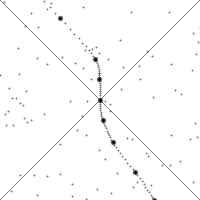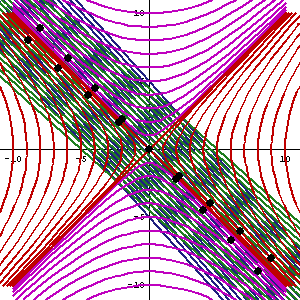I am your nightmare poster - a layman trying to learn special relativity. (I'm also a refugee from stackoverflow.com: trust me, it's only going to get worse). Apologies in advance if my question is nonsense or too open-ended. I won't be offended if you vote to close it.
I'm working through Taylor & Wheeler 'Spacetime Physics'. The book starts with a nice analogy of different teams of surveyors mapping out a world with different sized measuring rods (and even the same teams using different sized rods for different coordinate axes), and coming to realize that there is an underlying structure which is independent of the coordinate system. The idea is that spacetime intervals likewise give us the objective measuring stick by which we can map out spacetime (presumably by some process analogous to triangulation).
I'm just not able to intuit spacetime intervals like this, especially that distances in time and space have opposite sign. I can draw the diagrams and answer the exercises by plugging numbers into essentially the same equations over and over. Nor do I have any trouble working with the different inertial observers with all their meter rules and clocks. It's just the God's eye spacetime view which is eluding me. If intervals are real and objective, it ought to be possible to project this lattice of intervals onto the world and see it independently of any frame of reference (just like I can imagine the earth without the surveyors' grid lines superimposed on it). I accept that it might be some funny shaped space like a tennis ball turned inside out, but still...
So, my questions are: do you ever get a proper intuitive model for Minkowski spacetime, so that you can visualize the intervals, move objects about relativisticly in your mind's eye, and so on? If so, are there any tricks or insights which helped you get there? Do things 'really' move in your model, or is time just another static dimension like in the Minkowski diagrams?
Answer
Here's a little story comparing visualizing distances with visualizing spacetime intervals.
In plane Euclidean geometry, the shape that's invariant with respect to rotations is a circle. If you rotate a circle any amount, no one can tell. This is in contrast to other curves, which have at most discrete symmetries with respect to rotations.
If we have a Cartesian coordinate system, the equation for a circle of radius $R$ located at the origin is
$$x^2 + y^2 = R^2$$
The quantity $x^2 + y^2$ uniquely picks out which circle you're on, and everywhere on a given circle has the same value for that quantity.
If you draw a circle on a piece of graph paper, then put your finger down somewhere on the circle, then rotate the paper around the center of the circle while leaving your finger in the same spot, by the end of the rotation your finger is still on the same circle.
Thus, although the x-coordinate and y-coordinate under your finger change, the value of $x^2 + y^2$ does not. $x^2 + y^2$ is given the name "distance", and it is invariant with respect to rotations.
In 1+1 dimensional Minkowski spacetime, the shape that's invariant with respect to Lorentz boosts is a right hyperbola. If you boost a right hyperbola by any amount, no one can tell. This is in contrast to other curves, which have at most discrete symmetries with respect to boosts.
This Wikipedia image illustrates the action of boosts, which are less intuitive than rotations. The diagonal lines shown are essentially the special hyperbola $x^2 - y^2 = 0$.

If you watch a single point, it drifts downward when the observer is not accelerating because time is moving forward. When the observer accelerates, the point will quickly move along a hyperbola, then start drifting downwards again.
If we introduce a coordinate system, the general equation for a right hyperbola is
$$x^2 - t^2 = s^2$$
where $s^2$ can be positive or negative. The quantity $x^2 - t^2$ uniquely picks out which hyperbola you're on, and everywhere on a given hyperbola has the same value for that quantity.
If you draw a hyperbola on a piece of graph paper, then put your finger down somewhere on the hyperbola, then somehow made the paper undergo a hyperbolic rotation (i.e. Lorentz boost), by the end of the hyperbolic rotation your finger would still be on the same hyperbola.
The hyperbolic rotation can't be done with a normal sheet of paper, but it looks like this:

Thus, although the x-coordinate and t-coordinate under your finger change, the value of $x^2 - t^2$ does not. $x^2 - t^2$ is given the name "spacetime interval", and it is invariant with respect to Lorentz boosts.
This story begins by positing a transformation, then looking at what sort of shape is invariant under that transformation. Physically, I think it's a little more insightful to begin with the invariant - distance or spacetime interval - and then ask what transformations leave it invariant.
This is historically how the Lorentz transformations were discovered. They are linear transformations that leave Maxwell's equations invariant. Lorentz found them by searching for such transformations before Einstein published his first paper on relativity.
No comments:
Post a Comment